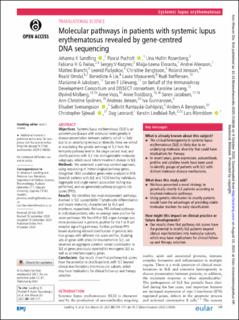| dc.contributor.author | Sandling, Johanna K. | |
| dc.contributor.author | Pucholt, Pascal | |
| dc.contributor.author | Hultin Rosenberg, Lina | |
| dc.contributor.author | Farias, Fabiana H.G. | |
| dc.contributor.author | Kozyrev, Sergey V. | |
| dc.contributor.author | Eloranta, Maija-Leena | |
| dc.contributor.author | Alexsson, Andrei | |
| dc.contributor.author | Bianchi, Matteo | |
| dc.contributor.author | Padyukov, Leonid | |
| dc.contributor.author | Bengtsson, Christine | |
| dc.contributor.author | Jonsson, Roland | |
| dc.contributor.author | Omdal, Roald | |
| dc.contributor.author | Lie, Benedicte Alexandra | |
| dc.contributor.author | Massarenti, Laura | |
| dc.contributor.author | Steffensen, Rudi | |
| dc.contributor.author | Jakobsen, Marianne A. | |
| dc.contributor.author | Lillevang, Søren T. | |
| dc.contributor.author | Lerang, Karoline | |
| dc.contributor.author | Molberg, Øyvind | |
| dc.contributor.author | Voss, Anne | |
| dc.contributor.author | Troldborg, Anne | |
| dc.contributor.author | Jacobsen, Søren | |
| dc.contributor.author | Syvänen, Ann-Christine | |
| dc.contributor.author | Jönsen, Andreas | |
| dc.contributor.author | Gunnarsson, Iva | |
| dc.contributor.author | Svenungsson, Elisabet | |
| dc.contributor.author | Rantapää-Dahlqvist, Solbritt | |
| dc.contributor.author | Bengtsson, Anders A. | |
| dc.contributor.author | Sjöwall, Christopher | |
| dc.contributor.author | Leonard, Dag | |
| dc.contributor.author | Lindblad-Toh, Kerstin | |
| dc.contributor.author | Rönnblom, Lars | |
| dc.date.accessioned | 2021-09-09T12:22:10Z | |
| dc.date.available | 2021-09-09T12:22:10Z | |
| dc.date.created | 2021-04-13T11:10:30Z | |
| dc.date.issued | 2021 | |
| dc.identifier.issn | 0003-4967 | |
| dc.identifier.uri | https://hdl.handle.net/11250/2774944 | |
| dc.description.abstract | Objectives Systemic lupus erythematosus (SLE) is an autoimmune disease with extensive heterogeneity in disease presentation between patients, which is likely due to an underlying molecular diversity. Here, we aimed at elucidating the genetic aetiology of SLE from the immunity pathway level to the single variant level, and stratify patients with SLE into distinguishable molecular subgroups, which could inform treatment choices in SLE.
Methods We undertook a pathway-centred approach, using sequencing of immunological pathway genes. Altogether 1832 candidate genes were analysed in 958 Swedish patients with SLE and 1026 healthy individuals. Aggregate and single variant association testing was performed, and we generated pathway polygenic risk scores (PRS).
Results We identified two main independent pathways involved in SLE susceptibility: T lymphocyte differentiation and innate immunity, characterised by HLA and interferon, respectively. Pathway PRS defined pathways in individual patients, who on average were positive for seven pathways. We found that SLE organ damage was more pronounced in patients positive for the T or B cell receptor signalling pathways. Further, pathway PRS-based clustering allowed stratification of patients into four groups with different risk score profiles. Studying sets of genes with priors for involvement in SLE, we observed an aggregate common variant contribution to SLE at genes previously reported for monogenic SLE as well as at interferonopathy genes.
Conclusions Our results show that pathway risk scores have the potential to stratify patients with SLE beyond clinical manifestations into molecular subsets, which may have implications for clinical follow-up and therapy selection. | en_US |
| dc.language.iso | eng | en_US |
| dc.title | Molecular pathways in patients with systemic lupus erythematosus revealed by gene-centred DNA sequencing | en_US |
| dc.type | Journal article | en_US |
| dc.description.version | publishedVersion | en_US |
| dc.rights.holder | Author(s) (or their employer(s)) 2021. | en_US |
| cristin.ispublished | true | |
| cristin.fulltext | original | |
| cristin.qualitycode | 2 | |
| dc.identifier.doi | 10.1136/annrheumdis-2020-218636 | |
| dc.identifier.cristin | 1903747 | |
| dc.source.journal | Annals of the Rheumatic Diseases | en_US |
| dc.source.pagenumber | 109-117 | en_US |
| dc.identifier.citation | Annals of the Rheumatic Diseases. 2021, 80 109-117. | en_US |
| dc.source.volume | 80 | en_US |
